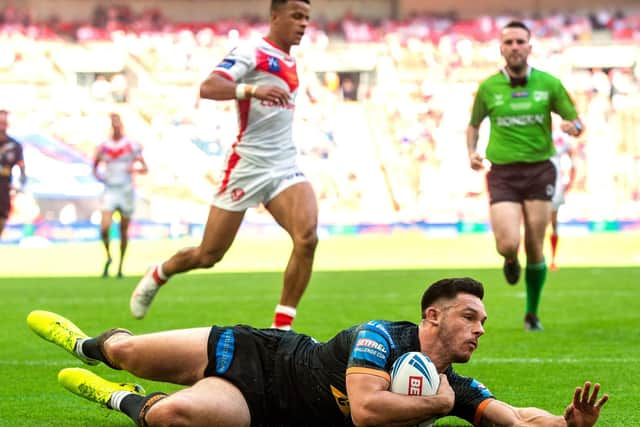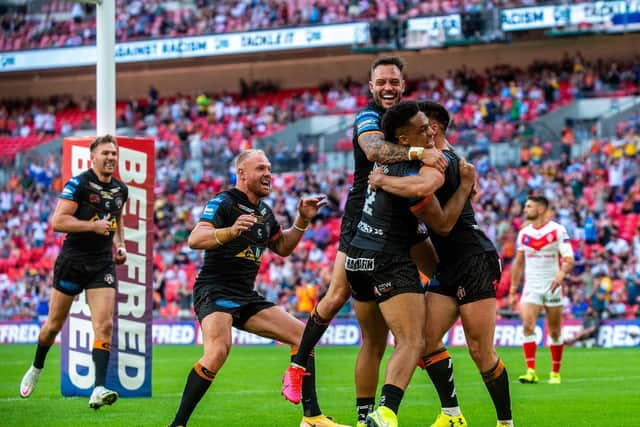Castleford Tigers v St Helens Wembley analysis: How a controversial try turned Challenge Cup final on its head
and live on Freeview channel 276
Thirty six years - 12,859 days to be exact - since they last lifted the trophy, Tigers led St Helens 12-6 and were clearly the better team in the fierce Wembley heat.
Before last Saturday, only one team had overcome a half-time deficit to win a Challenge Cup final at the new stadium.
Advertisement
Hide AdAdvertisement
Hide AdThat was Hull against Warrington Wolves in 2016, so Castleford’s fans - who rose to cheer their team off at the break - had every reason to feel confident.


Unfortunately for Tigers though, the tide turned in the second half and what might have been a new piece of Wembley history became a sadly familiar story.
It was the third final Castleford had lost since that famous victory over Hull KR and their third defeat in a major decider in the summer era, following Challenge Cup and Grand Final disappointments against Leeds Rhinos in 2014 and 2017.
Tigers played better than they did in either of those games and did not go behind until the 70th minute, but weren’t quite good enough in the end.
Advertisement
Hide AdAdvertisement
Hide Ad

Once Saints had levelled, in controversial fashion soon after the resumption, Tigers never really threatened to pull the game out of the fire, though the final margin flattered the winners.
Tigers coach Daryl Powell didn’t make a big issue of it, at least not publically, after the game, but Saints’ equalising try was one of those incidents teams need to go their way if they are going to win finals.
Lachlan Coote’s high appeared to be dropped by Mark Percival, bounced perilously close to the touchline and was then batted infield from Regan Grace.
Roby went over and after referee Liam Moore had signalled a try, both teams, television viewers and the 40,000 in the stadium endured an agonisingly long wait before video official Chris Kendall awarded the score.
Advertisement
Hide AdAdvertisement
Hide AdIt was hard to tell either way. From the press box, it appeared Percival had dropped the ball backwards, but it touched the whitewash before reaching Roby.
Either way, Powell’s disappointment in his post-match media briefing was aimed at his own players, who he felt should have made the catch and scrambled better to keep Saints out.
Saints received the game’s first penalty, but the other three in the opening period went to Tigers.
Advertisement
Hide AdAdvertisement
Hide AdThe second half count, though, was five-one to Saints and four in a row allowed them to keep Tigers on the back foot, draining energy from defenders in the tough conditions.
Coote was also able to increase Saints’ lead, crucially, to six and then eight points with kicks which also burned up some time when Castleford were chasing the game.
Led by Roby, though he did make a couple of uncharacteristic errors, Saints’ game-management was very good in the second half and when Tigers managed to attack, the winners defended solidly.
Castleford, though, don’t have anything to beat themselves up about.
Advertisement
Hide AdAdvertisement
Hide AdIt was a terrific final, particularly the nip and tuck opening 40 minutes and just the sort of contest the sport needed to put on for a national audience in a World Cup year.
Both teams deserve huge credit for being able to stage any sort of spectacle in sapping, 30-plus degree heat, which made even watching from the stands an uncomfortable experience.
Some Cas players looked almost out on their feet in the later stages, but they never gave up the ghost and Kyle Amor’s try a couple of minutes from time was harsh on them.
Tigers left the stadium with some silverware.
Advertisement
Hide AdAdvertisement
Hide AdFor only the 11th time in its history, which goes back to 1946, the Lance Todd Trophy, awarded to the man of the match, went to a player on the losing team.
Tigers full-back Niall Evalds polled 18 votes from members of the media, five more than Roby.
Others went to Saints full-back Lachlan Coote (five), stand-off Jonny Lomax (three) and winger Tommy Makinson (one)
Tigers forward Jesse Sene-Lefao also attracted one vote.
Evalds, who also received a couple of votes last year after Salford’s defeat by Leeds, is Castleford’s fourth Lance Todd winner, following Bob Beardmore (1986), Bill Kirkbride (1970) and Malcolm Reilly (1969).
Advertisement
Hide AdAdvertisement
Hide AdHe had a superb game, scoring Tigers’ opening try, defending well and offering a threat with the ball.
He might well have touched down again, but for a terrific tackle by his opposite number Coote in the second half.
Saints went ahead thanks to Theo Fages’ ninth minute try after a kick by Lomax rebounded off a post.
But Cas hit back with a scorcher soon afterwards when Evalds collected Peter Mata’utia’s kick, after initially sending the centre racing clear.
Advertisement
Hide AdAdvertisement
Hide AdJake Trueman, returning from injury, scored Cas’ second from a kick to the posts by Gareth O’Brien, who converted both.
After Roby’s try, Saints regained the lead on 51 minutes through Tommy Makinson and Amor crashed over late on to finish it.
Coote converted three of Saints’ four tries and two penalties from three attempts.
Support the YEP and become a subscriber today. Enjoy unlimited access to local news and the latest on Leeds United, With a digital subscription, you see fewer ads, enjoy faster load times, and get access to exclusive newsletters and content. Click here to subscribe.
Comment Guidelines
National World encourages reader discussion on our stories. User feedback, insights and back-and-forth exchanges add a rich layer of context to reporting. Please review our Community Guidelines before commenting.
